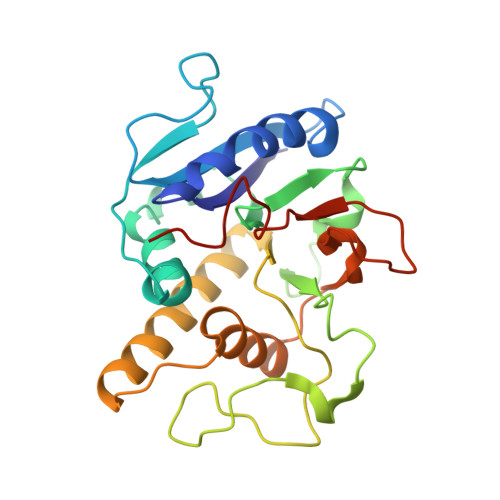Structures of Complexes of a Metal-Independent Glycosyltransferase Gt6 from Bacteroides Ovatus with Udp-Galnac and its Hydrolysis Products.
Pham, T.T.K., Stinson, B., Thiyagarajan, N., Lizotte-Waniewski, M., Brew, K., Acharya, K.R.(2014) J Biological Chem 289: 8041
- PubMed: 24459149
- DOI: https://doi.org/10.1074/jbc.M113.545384
- Primary Citation of Related Structures:
4CJ8, 4CJB, 4CJC - PubMed Abstract:
Mammalian members of glycosyltransferase family 6 (GT6) of the CAZy database have a GT-A fold containing a conserved Asp-X-Asp (DXD) sequence that binds an essential metal cofactor. Bacteroides ovatus GT6a represents a GT6 clade found in more than 30 Gram-negative bacteria that is similar in sequence to the catalytic domains of mammalian GT6, but has an Asn(95)-Ala-Asn(97) (NXN) sequence substituted for the DXD motif and metal-independent catalytic activity. Co-crystals of a low activity mutant of BoGT6a (E192Q) with UDP-GalNAc contained protein complexes with intact UDP-GalNAc and two forms with hydrolysis products (UDP plus GalNAc) representing an initial closed complex and later open form primed for product release. Two cationic residues near the C terminus of BoGT6a, Lys(231) and Arg(243), interact with the diphosphate moiety of UDP-GalNAc, but only Lys(231) interacts with the UDP product and may function in leaving group stabilization. The amide group of Asn(95), the first Asn of the NXN motif, interacts with the ribose moiety of the substrate. This metal-independent GT6 resembles its metal-dependent homologs in undergoing conformational changes on binding UDP-GalNAc that arise from structuring the C terminus to cover this substrate. It appears that in the GT6 family, the metal cofactor functions specifically in binding the UDP moiety in the donor substrate and transition state, actions that can be efficiently performed by components of the polypeptide chain.
- From the Department of Biology and Biochemistry, University of Bath, Claverton Down, Bath BA2 7AY, United Kingdom and.
Organizational Affiliation:



















